We’re glad that the Bi-centennial Committee saw fit to recognize several Jewish congregations, having given considerable attention to various individual Christian churches, but we’re sorry to say that the marker failed to note that Albany was, for a critical time, the home of one of the most important figures in American Judaism, Rabbi Isaac Mayer Wise. At the time of his death, Rabbi Wise, who introduced key reforms, was called the foremost Rabbi in America.
But first let’s look at the tablet itself. If it still exists, we haven’t located it, but as with all the missing tablets, we’re hopeful someone might know where it is.
No. 46, “Jewish Congregations.” “The first Jewish congregation (Beth-El) was organized March 25, 1838; Beth-El Jacob, March 10, 1841; Anshe-Emeth, October 11, 1850; Sons of Abraham, March 4, 1882; Beth-El and Anshe-Emeth were consolidated under the name Beth-Emeth, Dec. 1, 1885.”
In 1914, The Argus article on the condition of the bicentennial tablets provided us with the copy above saw fit to note that this was one of three tablets that had been “refastened with slot-headed screws, instead of having the heads filed flat as originally.” Still, they noted that it was on the southwest corner of Lancaster and South Swan streets, so it still existed. “This latter tablet does not mark a locality, but is a record of the various congregations. It was removed from the lower part of the city after the erection of Temple Beth-Emeth.” If true, then we have no indication of where it was originally sited – this is one of the several tablets that weren’t listed in the original Bi-Centennial Committee publication. But of course, that corner was, as of 1887, occupied by the Temple Beth Emeth building, and it would have been a logical location for the tablet.
A history on the Congregation Beth-Emeth site says that the first impetus for organizing a synagogue under the name of Beth El came in 1838, and that a year following they purchased 166 Bassett Street. It also says that a “splinter group” left early in 1841 to form Congregation Beth El Jacob on Rose Street, which was a short street between Madison and Hamilton one block east of South Pearl (now lost beneath the South Mall Arterial).
The remaining Beth El congregation purchased a church at 76 Herkimer Street from the Hibernian Benevolent Society. The congregation also acquired two acres of land in Bethlehem for a cemetery in 1843. (Other sources give some different dates of organization, construction, etc., but they’re in rough agreement.)
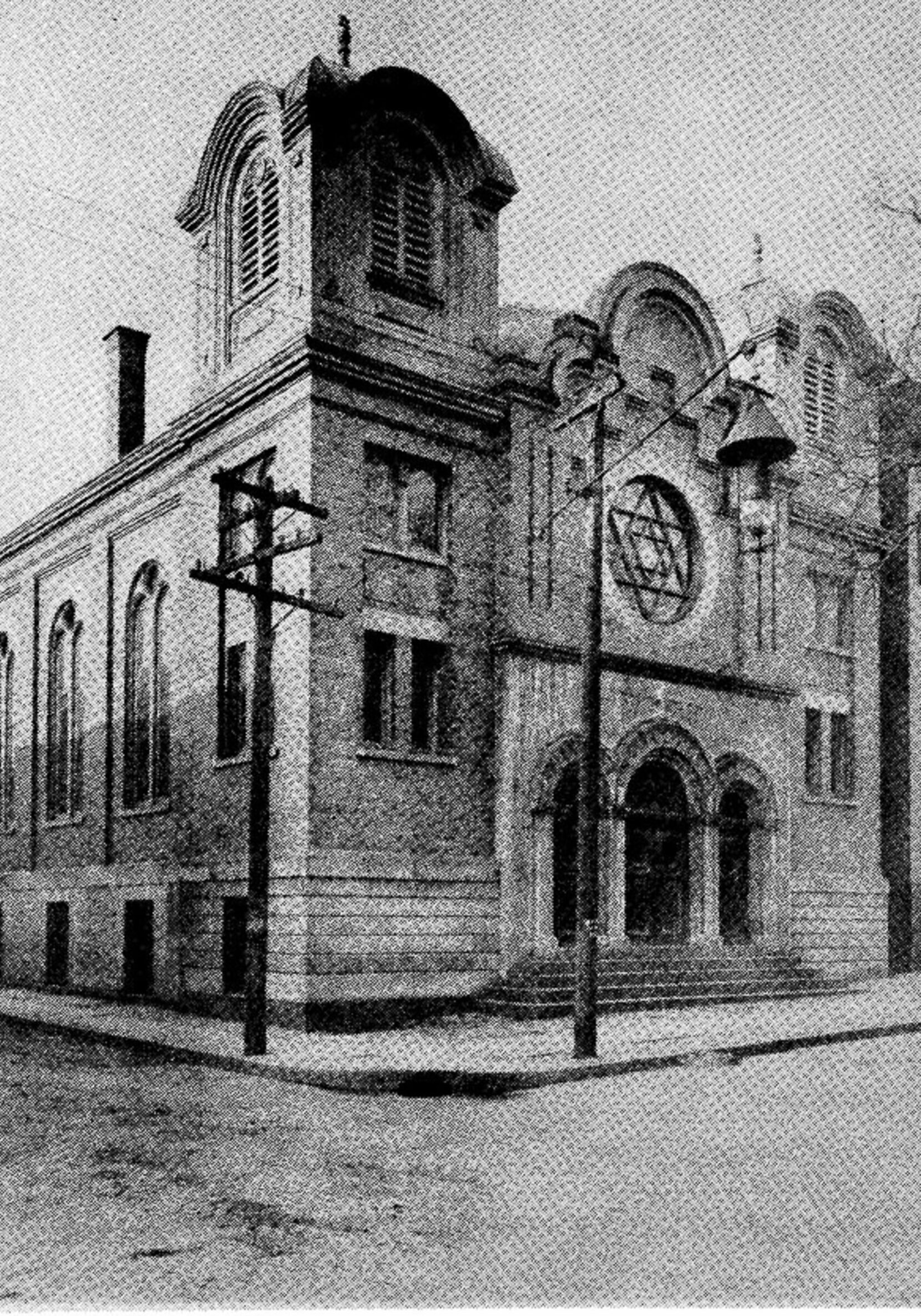
Beth El and Anshe Emeth
According to the 1902 Funk & Wagnall “The Jewish Encyclopedia,”
“As early as 1661, when Albany was but a small trading post, a Jewish trader, named Asser Levi (or Leevi) became the owner of real estate there . . . To trade in the colony in those days it was necessary to acquire burghers’ rights, and one of the conditions essential to the acquisition of such rights was the ownership of real estate. This probably accounts for the ownership at that time of real estate in Albany by this Jewish trader.”
However, Levi was a resident of New York City, never of Albany. The Jewish Encyclopedia writes that during the early years of the 19th century, a number of German Jews, principally from Bavaria, settled in the city, but it wasn’t until 1838 that the first congregation, Beth-El, was organized, meeting first somewhere on Bassett Street and then on Herkimer Street.
“The congregation had no rabbi regularly officiating at its services until the fall of 1846, when the Rev. Isaac M. Wise, then just entering upon his career, was gladly welcomed to the place. He remained at Albany eight years, during which time he introduced many reforms in the service of the synagogue. These reforms, and the frank utterances in his sermons in defense of them, produced such violent opposition on the part of some of the members of the congregation, that at the end of the fourth year of his incumbency the opposition had grown very bitter, even to personal violence, and caused a division in the congregation.”
Wise may have been a divisive character, but he left a lasting imprint, often essentially credited as a driving force of Reform Judaism in the United States. His adherents organized a new Congregation Anshe Emeth on Oct. 11, 1850 and appointed him rabbi; they purchased a former church on South Pearl Street and converted it into a synagogue, where Wise continued as rabbi until he departed for Cincinnati in 1854. “It was during his last year at Albany that Wise published the first volume of The History of the Israelitish Nation from Abraham to the Present Time, Derived from the Original Sources.“
The Beth Emeth site’s history explains that this new congregation, Anshe Emeth (“People of Truth”) met in a rented building at Madison and South Pearl, and was the fourth Reform Jewish congregation in America. They moved to Green and Hamilton, and then bought a former Baptist church at South Pearl and Herkimer streets in Sept. 1851. This congregation, the same year, purchased two acres of land adjacent to Albany Rural Cemetery as a cemetery.
“The Jewish Encyclopedia” doesn’t give much more information on Beth-El, other than that those who did not follow Dr. Wise remained in Herkimer street until 1865, when they built a synagogue at the corner of South Ferry and Franklin streets. “During that time their religious services were conducted by Revs. S. Falk, Gotthold, H. Birkenthal, Son, and Friedman.” Another source, the Congregation Beth Abraham-Jacob website, says that:
On July 14, 1864, Beth El Synagogue purchased a Methodist Episcopal church on the corner of Franklin and Ferry Streets and it was dedicated as a synagogue in December of that year. As Anshe Emeth and Beth El mended fences, many congregants of the Orthodox synagogue were becoming less observant. On December 1, 1885 Beth El and Anshe Emeth merged and became known as Congregation Beth Emeth. Beth El-Jacob became the only Orthodox congregation in Albany.
The encyclopedia notes that Wise was succeeded by Elkan Cohn until 1862, Moritz Mayer until 1864, and then Dr. Max Schlesinger. “With Dr. Schlesinger as its rabbi the Anshe Emeth Congregation continued until 1885, when it consolidated with that of Beth-El, the united congregation being named the Beth-Emeth. This merging of the two congregations necessitating a larger place of worship, a handsome synagogue, costing $145,000, was built at the corner of Lancaster and Swan streets, and it was dedicated on May 24, 1889.”
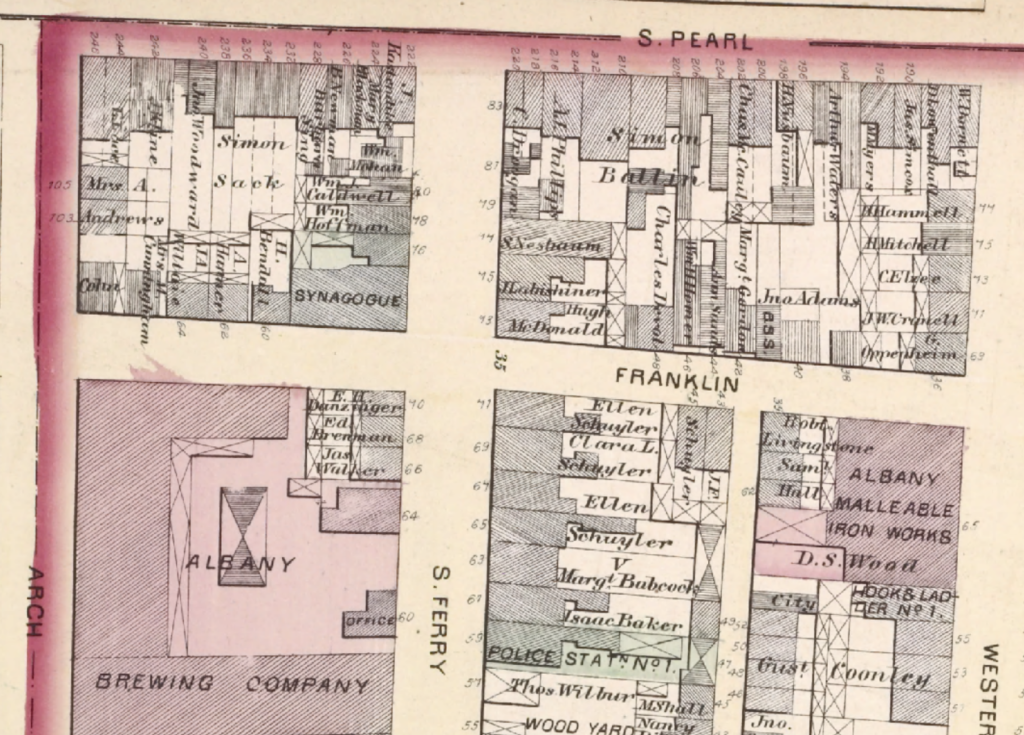
The new temple, built on land between Lancaster, Jay and Swan streets, involved Isaac G. Perry, then the architect and supervisor of the construction of the new Capitol building. However, it appears the main architect was likely Adolph Fleischman of Albany, a member of the congregation. The cornerstone was laid Nov. 24, 1887 and the first congregational worship in January 1889. Beth El’s building on Ferry and Franklin was sold to the Orthodox shul Congregation Sons of Abraham.
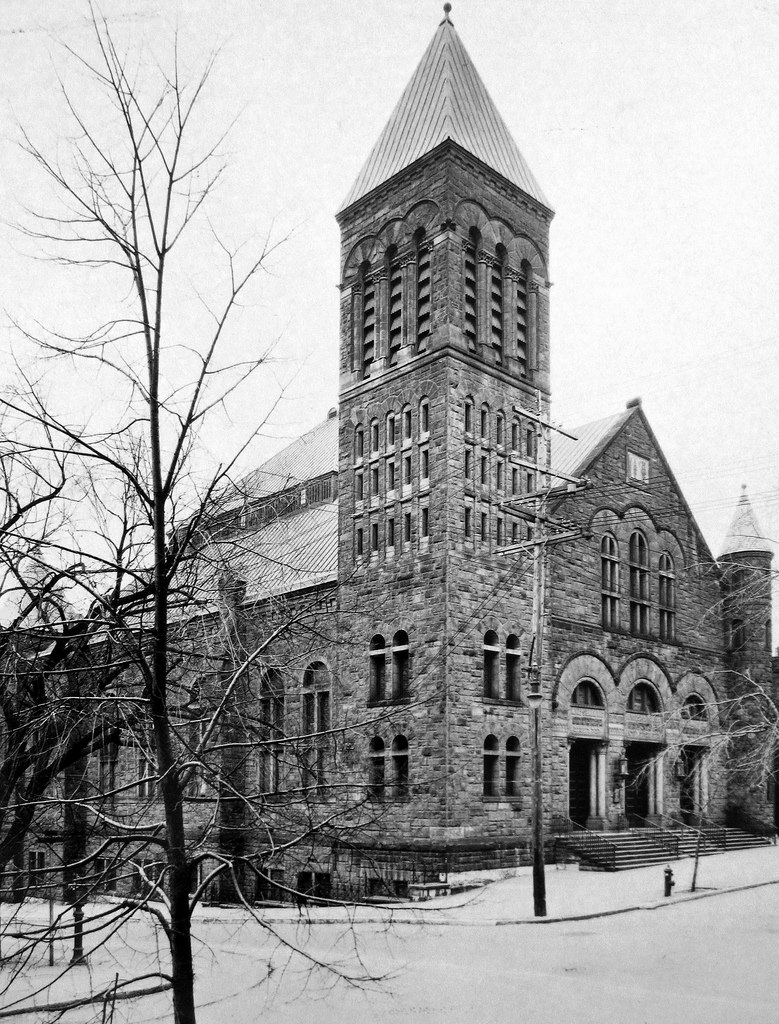
Diana Waite wrote of the new building:
It was designed by a member of the congregation, Adolph Fleischman; Isaac Perry, then supervising architect of the Capitol, served as consulting architect. Much of the temple’s inspiration comes from H.H. Richardson’s recently completed Albany City Hall (1881-83) – the hipped roof, rusticated stone, massing around a corner tower and triple-arched doorway decorated with carvings in English and Hebrew.
Albany Architecture: A Guide To The City, edited by Diana S. Waite
The cornerstone of the new Beth Emeth was laid with ceremonies on Thanksgiving afternoon in 1887, and inside the cornerstone was placed a box of records – a time capsule. The Hon. Simon W. Rosendale (later the first Jew elected to statewide office in New York, winning the election for Attorney General in 1891) said “We believe that in the erection of this house of worship we discharge a duty to society at large and to our city – to the first in making permanent an organized factor for good – a wholesome instrumentality in the body politic – to the second in constructing on this choice spot a building which in form and construction will be a credit to the city and to the State, and which, with the towers of neighboring houses of worship, will lift its form an additional witness to the religious element prevailing in our community.”
The Argus reported that the box placed in the cornerstone contained: the constitution and by-laws of the congregation Beth Emeth; list of members and seat holders, list of subscribers and amounts donated, list of members of choir and organist, list of Beth Emeth Sunday scholars and teachers, list of building committee and contractors; by-laws of congregation Beth El; by-laws of Anshe Emeth; constitution of Independent Order of B’ne B’rith; laws of District Grand Lodge No. 1, and history of Shiloh lodge, No. 17. I.O.B.B. 111ch, and by-laws of Gideon lodge, No. 140, by M.I.O.B.B.; constitution of Independent Free Sons of Israel; laws of District Grand Lodge No. 1 and by-laws of Arnon lodge No. 64; I.O.F.S of I.; constitution of most worthy grand lodge Kesher Shel Barzel, laws of district No. 1 and by-laws of Albany City Lodge, No. 68, K.S.B., by-laws of B’nai Mordiachia lodge, No. 68, K.S.B., constitution and laws of Independent Order Treuer Schwestern, and by-laws of Abigai lodge, No. 3, constitution and by-laws of Ladies’ Benevolent association of congregation of Beth Emeth, constitution of Society for Providing a Home for Aged, Infirm and Destitute Israelites in the city of Albany, annual report of board of managers of the Jewish Home society for 1887 and names of its members, constitution and by-laws of the Adelphia club, Menorah, the official organ of the Independent Order of B’ne Brith, historical facts and programme for laying the corner-stone of the new synagogue, order of exercises for laying of corner-stone, copies of the Hebrew Journal, the American Hebrew, the Hebrew Standard, the Jewish Messenger, and the Deborah, advance sheets of the bi-centennial volume, City Directory for 1887, copies of Press and Knickerbocker, Argus, Express, Journal, Union Times, Post, Freie Blaetter and Albany Herold, Hebrew calendar for 1887 and 1888, steel engravings of Sir Moses Montefiore and Rev. Dr. Isaac Wise.
Inscribed silver trowels were presented to Mayor John Boyd Thacher and congregation President Julius Lavertell, who both leveled mortar on the stone containing the box, after which the stone was rolled into its place and set.
So things remained until Beth Emeth made plans to move out to Academy Road in the mid 1950s, with a formal dedication of the new Beth Emeth on erev (the day before) Rosh Hashanah, September 1957. After that, the Wilborn Temple Church of God in Christ purchased the Center Square temple, where it continues to this day.
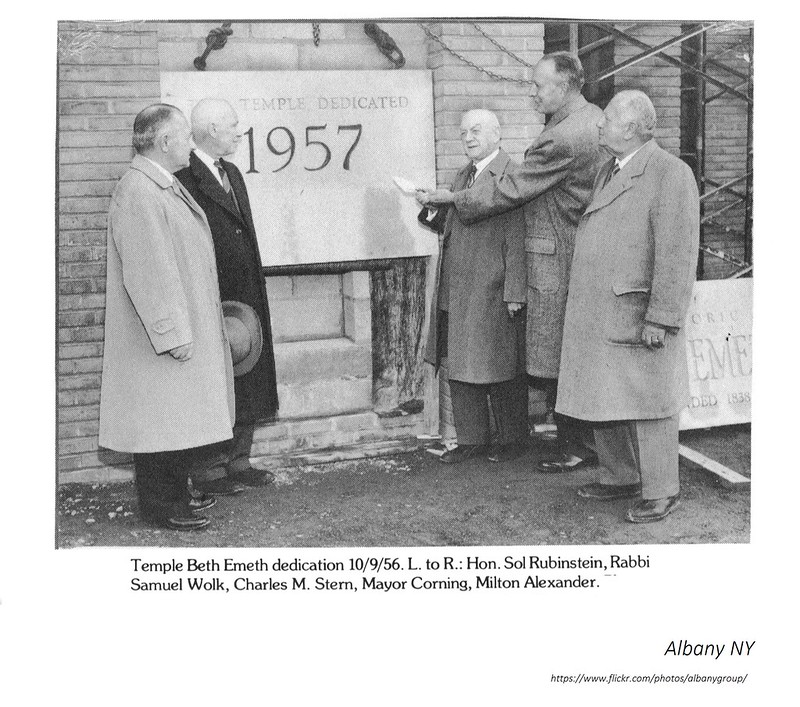
Beth El Jacob and Agudas Achim
A history of the congregation given by the Congregation Beth Abraham-Jacob website fills in the details of this group that originally split off from Beth El as Beth El Jacob in 1841:
In early 1841 eleven members left Congregation Beth El and formed a new congregation, Beth-El Jacob, holding services at 8 Rose Street until they built a synagogue at 28 Fulton Street. It remained there until 1910, when it moved to 90 Herkimer Street.

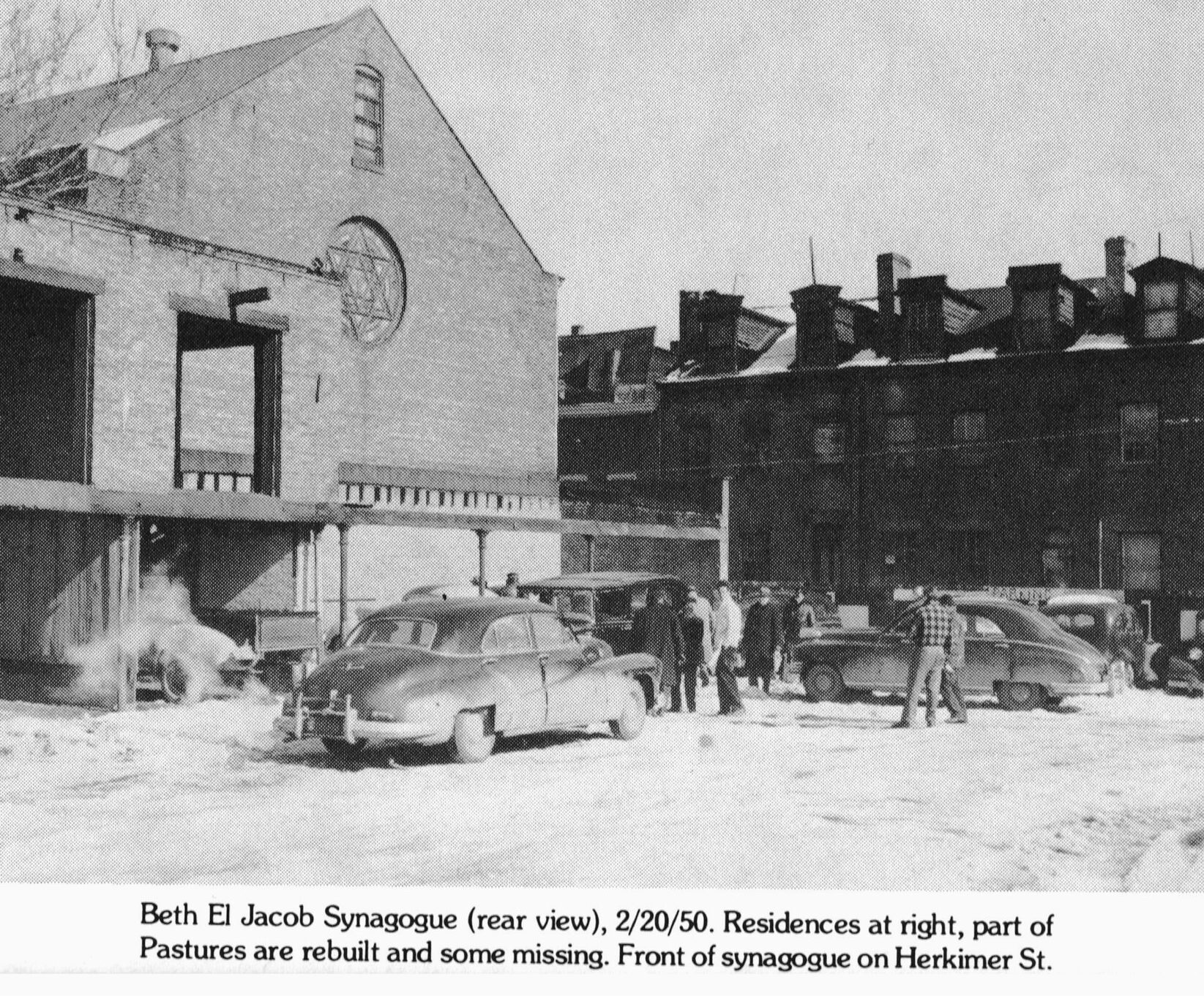
As the German Jewish population flourished during the 1880s, newer and poorer immigrants were not comfortable with the more established community. In 1883, they formed their own synagogue, Congregation B’nai Abraham (Sons of Abraham), located at 69 South Pearl Street, where the Times Union Center now stands. In 1885 Congregation B’nai Abraham bought the former Beth El Synagogue at the corner of Franklin and Ferry Streets, made alterations to provide space for women, and dedicated the building on April 11, 1886. Congregations Beth El-Jacob and B’nai Abraham became the more established Orthodox synagogues in Albany and remained the mainstays of the community for most of the 20th century.
The United Brethren Society formed Agudas Achim in 1905; they began in a hall on South Pearl, then moved to Broad Street, and then to 71 Ferry Street. This group merged with Beth El-Jacob in 1959. Ultimately, with further combinations detailed on their website, this Orthodox congregation continues on Whitehall Road.
Apologies for inconsistent use of hyphens throughout; the source and contemporary materials freely mix the application of hyphens to names such as “Beth-El” and “Beth-Emeth.”

Leave a Reply